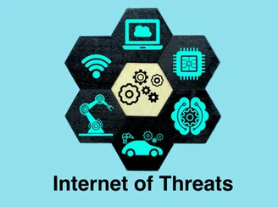Internet of Things (IoT)A network of physical objects embedded with sensors, software, and other technologies, designed to connect and exchange data with other devices and systems over the internet. These objects range from ordinary household items to sophisticated industrial tools.
See More...
See Less...
devices such as fitness trackers and home security cameras are growing in popularity. Still, many people don’t realize that these devices can also be used to attack critical infrastructure. In 2017, a group of hackers used IoTA network of physical objects embedded with sensors, software, and other technologies, designed to connect and exchange data with other devices and systems over the internet. These objects range from ordinary household items to sophisticated industrial tools.
See More...
See Less...
devices to launch a massive attack on the internet infrastructure provider Dyn, and they were only able to do this because they could exploitA method or piece of code that leverages a bug, glitch, or vulnerability in software or hardware to trigger unintended or unforeseen behavior. This behavior often includes gaining control over a system, acquiring elevated privileges, or accessing restricted data. While the term "exploit" can imply malicious intent, in computer security, it specifically refers to the act of using vulnerabilities, not necessarily the intent behind it. Exploits can be used for malicious purposes, but they can also be used for testing or protective measures by security professionals.
See More...
See Less...
devices that were using default passwords.
 As more and more IoT devices are released, the number of potential attack vectorsIn cybersecurity, a threat vector is a path or means by which a hacker or a malicious program can gain access to a computer or network server in order to deliver a payload or malicious outcome. Threat vectors enable attackers to exploit system vulnerabilities, including the human element, and typically include malware, phishing, and other forms of attack that can compromise data security.
See More...
See Less...
is growing exponentially. A recent study found that the number of IoT devices will exceed 30 billion by 2020 and that many of these devices will need more security features. This means that hackers will have an even easier time launching attacks against critical infrastructure.
As more and more IoT devices are released, the number of potential attack vectorsIn cybersecurity, a threat vector is a path or means by which a hacker or a malicious program can gain access to a computer or network server in order to deliver a payload or malicious outcome. Threat vectors enable attackers to exploit system vulnerabilities, including the human element, and typically include malware, phishing, and other forms of attack that can compromise data security.
See More...
See Less...
is growing exponentially. A recent study found that the number of IoT devices will exceed 30 billion by 2020 and that many of these devices will need more security features. This means that hackers will have an even easier time launching attacks against critical infrastructure.
Some of the most vulnerable sectors include election systems, healthcare providers, and energy companies. Election officials are already beginning to worry about the potential for cyberattacks that could interfere with the voting process. Healthcare providers are at risk of having their patient dataData, in everyday terms, refers to pieces of information stored in computers or digital systems. Think of it like entries in a digital filing system or documents saved on a computer. This includes everything from the details you enter on a website form, to the photos you take with your phone. These pieces of information are organized and stored as records in databases or as files in a storage system, allowing them to be easily accessed, managed, and used when needed.
See More...
See Less...
stolen, and energy companies are at risk of having their systems hacked and sabotaged.
The good news is that some steps can be taken to mitigate the risk of IoT-based attacks. For example, companies can enforce strong password policies and ensure that devices are updated with the latest security patches. Additionally, it is crucial for people to be aware of the potential risks associated with using IoT devices and to take steps to protect their devices from hackers.
In the face of the ever-growing threats posed by IoT devices to election, healthcare, and energy infrastructure, it is more important than ever for governments, businesses, and individuals to be aware of the dangers and take steps to mitigate them. While there is no one-size-fits-all solution to the problem, by being aware of the risks and taking steps to secure devices, networksA collection of interconnected computers, servers, and other devices that allow for the exchange and sharing of data and resources. Networks can be classified based on size, function, and access. Common types include Local Area Network (LAN), which connects devices in a localized area such as an office or home; Wide Area Network (WAN), which connects devices across large distances, possibly globally; and Virtual Private Network (VPN), which provides secure, encrypted connections over the internet. A network relies on standardized protocols, such as TCP/IP, to ensure uniform communication and data transfer between devices.
See More...
See Less...
, and data, we can help to make these critical systems more resilient to attack.
 As more and more IoT devices are released, the number of potential attack vectors is growing exponentially. A recent study found that the number of IoT devices will exceed 30 billion by 2020 and that many of these devices will need more security features. This means that hackers will have an even easier time launching attacks against critical infrastructure.
As more and more IoT devices are released, the number of potential attack vectors is growing exponentially. A recent study found that the number of IoT devices will exceed 30 billion by 2020 and that many of these devices will need more security features. This means that hackers will have an even easier time launching attacks against critical infrastructure.









